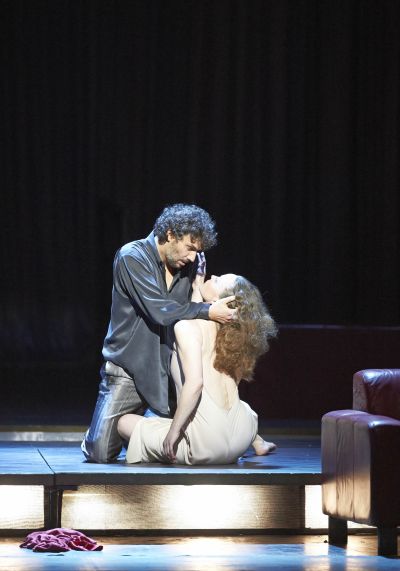|
|
|
|
|
|
|
Seen and Heard International, April 8, 2013 |
| Simon Thompson |
|
|
|
Wagner: Parsifal, Wiener Staatsoper, 4. April 2013 |
|
|
Vienna’s Parsifal Runs Far Ahead of the Pack
|
|
|
|
|
 Parsifal
has become a fairly regular fixture in Vienna at Easter time and this year I
was lucky enough to catch the last of 2013′s three performances. The main
draw was Jonas Kaufmann’s assumption of the title role, his third after
Zurich and last month’s production at the Met, which you may have seen in
the cinema. More of him later. Parsifal
has become a fairly regular fixture in Vienna at Easter time and this year I
was lucky enough to catch the last of 2013′s three performances. The main
draw was Jonas Kaufmann’s assumption of the title role, his third after
Zurich and last month’s production at the Met, which you may have seen in
the cinema. More of him later.
Before we get onto the music, a few
words about Christine Mielitz’s production which, sadly, I found distracting
and visually confused. The opening draws attention to the depraved condition
of the knights, an insight showcased by Nikolaus Lehnhoff’s ENO production
and recently followed by many. Mielitz sets the knights’ realm in what looks
like a crumbling changing room; Amfortas takes his bath behind the sink and
the knights themselves seem to have been reduced to the level of a mere
fencing club – we see them practising their parries during Gurnemanz’s Act 1
narrative. Inexplicable features abound, though. The order seems to be
involved in human sacrifice of some kind and, even more oddly, there is a
suggestion that the spirits of the victims provide the disembodied voices
for the Act 1 choruses. Klingsor is a cross between a Bond villain and a
pimp, and his “garden” resembles a red-light brothel for most of Act 2. It’s
all rather odd, though I enjoyed the bare emptiness of the final act, where
the lack of clutter helped the story to unfold more naturally.
The
music, on the other hand, was a cut above anything else I’ve heard in this
work before. If you heard Kaufmann’s Parsifal from the Met then you
won’t need me to praise the glories of his voice in this role, which suits
him perfectly. Hs dark, burnished timbre is perfect for the character of the
wounded healer, the hero who must suffer before he achieves his purpose.
Kaufmann has just recovered from a bout of illness, and I got the impression
that he was undersinging the part to help him to get through it; but if the
voice lacked power then it suffered no lack of beauty or conviction. The
naïveté of his interplay with the Flower Maidens was very winning, moderated
into something approaching awe when he encounters Kundry. Then a palatable
transformation comes over the voice at “Amfortas! Die Wunde!”, developing
much greater resources of power. By the final act, and particularly the very
final scene in the Grail Temple, his voice rings with authority in a way
that I found thrilling and compelling: he goes on a vocal journey every bit
as important as the hero’s spiritual journey, and we as an audience are all
the richer for it.
This is far from being a one-man show,
though. Evelyn Herlitzius is a brittle, electric Kundry, who always retains
a hint of instability, even in her seduction scene, which is very beautiful.
There is a hint of gravel in Tomasz Koniecczny’s voice which does not give
much beauty to his portrayal of Amfortas, but he underlines the king’s agony
all the more powerfully, and the drama of the final scene is extraordinary.
Wolfgang Bankl is a fantastically malevolent Klingsor, embodying the role’s
physical menace as well as his nasty energy. The anchor of the whole
evening, though, was the extraordinary Gurnemanz of Kwangchul Youn, a truly
awesome Wagner talent. His Gurnemanz manages to sound young while retaining
immense reserves of authority and power, and his portrayal of the role rises
to a magisterial climax with the anointing scene of Act 3, the most
thrilling account of this key moment that I have ever heard.
Vienna
can draw great singers, but what really sets apart an evening in this opera
house is the quality of the regulars. Maybe it’s because I was so close to
them, but the quality of the chorus blew me away. The ladies made a superb
bunch of Flower Maidens, and the singing of the knights in the outer acts
was extraordinary, redolent with the conviction of their calling in the
first act and full of sinister malevolence in the third. It was the playing
of the orchestra that really set the evening on fire, though. When you have
the Vienna Philharmonic in the pit the results are sure to be special, and
so it proved. This is musicianship that runs ahead of the pack. The brass
have a magisterial quality that lends immense power to the climaxes of the
grail scenes and the winds have a luminosity that fits the colours of
Wagner’s final score perfectly. It’s hard to know where to start praising
the strings, too. They shimmered with intensity in the Prelude and in the
grail scenes, seeming to hang in mid-air unaided, but then attacked the
prelude to Act 2 with demonic energy that seemed about to leap out of the
pit. Act 3 was a marvel from start to finish, from the weary emptiness of
the prelude, through the miraculous wash of string sound that accompanied
the removal of Parsifal’s helmet, to the luminous beauty of the Good Friday
Music, the unstoppable power of the transformation music and the unarguable
resolution of the final pages. I’m sure I’ll see a better Parsifal before
long, but if I ever hear another one as good as this then I’ll count myself
a lucky man.
|
|
|
|
|
|